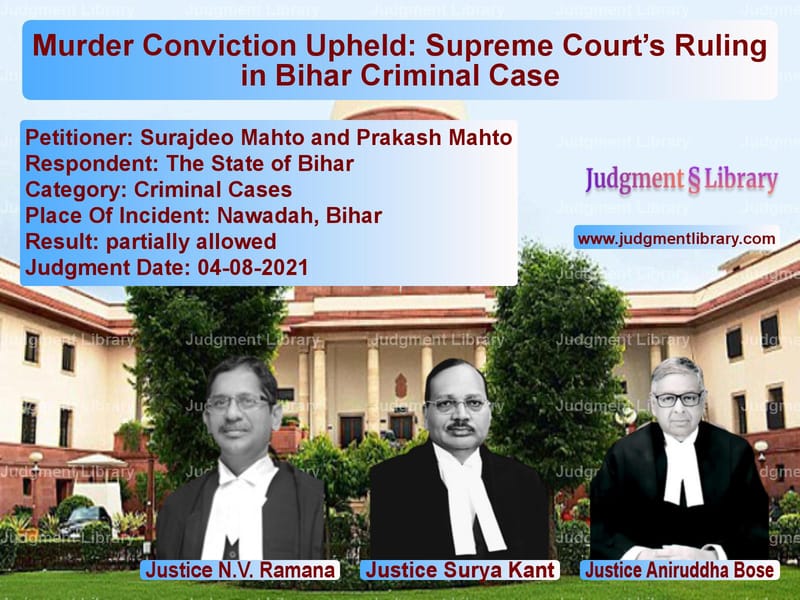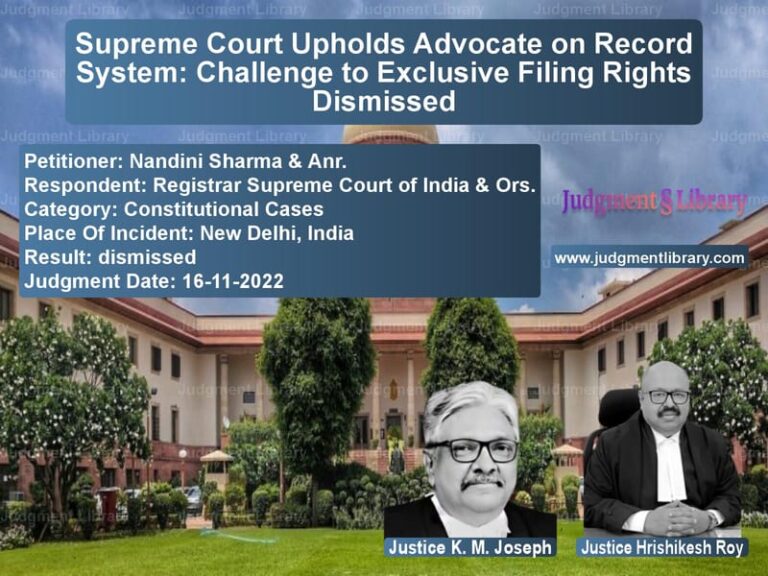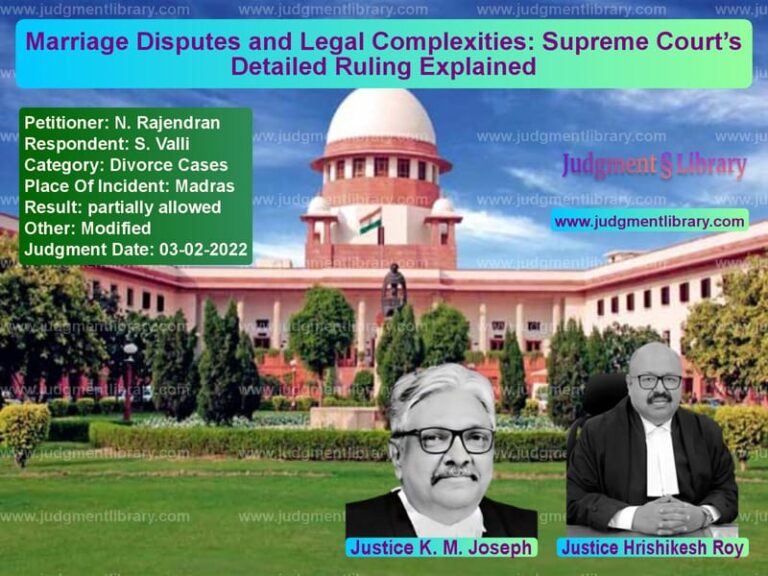Murder Conviction Upheld: Supreme Court’s Ruling in Bihar Criminal Case
The case of Surajdeo Mahto and Prakash Mahto versus the State of Bihar is a complex criminal matter involving a murder conviction under Sections 302, 364, and 120-B of the Indian Penal Code (IPC). The Supreme Court examined the circumstantial evidence, the legal principles governing criminal conviction, and the plea of juvenility raised by one of the appellants. Ultimately, the Court upheld the conviction of Surajdeo Mahto while acquitting Prakash Mahto.
Case Background
The case revolved around the murder of Arun, whose body was discovered in Ram Sagar Ahar near Kakolat on April 11, 1987. The prosecution alleged that Surajdeo Mahto (Appellant No.1) and Prakash Mahto (Appellant No.2) lured the deceased from his home under the pretense of watching a cinema show. The prosecution’s case was based on circumstantial evidence, particularly the ‘last seen theory,’ which placed the deceased in the company of the accused shortly before his disappearance.
Read also: https://judgmentlibrary.com/supreme-court-clarifies-premature-release-policy-for-life-convicts/
The appellants were convicted by the 3rd Additional Sessions Judge, Nawadah, on May 13, 1988. Their conviction was subsequently upheld by the Patna High Court on May 20, 2010. Seeking relief, they approached the Supreme Court, challenging their conviction and the reliance on circumstantial evidence.
Arguments by the Petitioners
The petitioners raised several key contentions in their defense:
- The case was entirely based on circumstantial evidence, with no eyewitness to the actual crime.
- The prosecution witnesses were primarily relatives and close associates of the complainant, raising concerns about bias.
- The evidence presented against Appellant No.2 (Prakash Mahto) was weak, consisting only of last-seen testimony and alleged suspicious conduct.
- The prosecution failed to conduct a forensic examination of the knife recovered at the scene.
- Appellant No.1 (Surajdeo Mahto) argued that he was a juvenile at the time of the offense and should be tried under the Juvenile Justice (Care and Protection of Children) Act, 2000.
Arguments by the Respondents
The State of Bihar, representing the prosecution, countered the petitioners’ claims by presenting the following arguments:
- The case involved a strong chain of circumstantial evidence proving the appellants’ guilt beyond reasonable doubt.
- “The accused lured the deceased on the pretext of watching a cinema show and subsequently provided false information about his whereabouts,” the prosecution argued.
- The last-seen theory was supported by multiple witnesses, including family members and independent individuals.
- Seized items, including a lungi identified as belonging to Appellant No.1, further strengthened the case against him.
- The plea of juvenility raised by Appellant No.1 was a last-minute attempt to escape conviction and was not supported by credible documentary evidence.
Supreme Court’s Analysis
The Supreme Court carefully examined the case, considering the five cardinal principles governing circumstantial evidence as established in Sharad Birdhichand Sarda v. State of Maharashtra. The Court evaluated whether the prosecution successfully excluded all hypotheses of innocence.
The Court observed:
- “The circumstances from which the conclusion of guilt is to be drawn should be fully established.”
- “The facts so established should be consistent only with the hypothesis of the guilt of the accused, that is to say, they should not be explainable on any other hypothesis except that the accused is guilty.”
- “There must be a chain of evidence so complete as not to leave any reasonable ground for the conclusion consistent with the innocence of the accused.”
Last Seen Theory
The Court found that the prosecution had successfully established that the deceased was last seen in the company of the appellants. Witnesses deposed that Arun was taken by the accused to see a cinema, and he was later seen with them at different locations. The Court emphasized that while last-seen evidence alone may be insufficient, when coupled with false explanations from the accused, it could establish guilt.
Motive
The prosecution argued that the accused had a strong motive: a dispute arising from an alleged illicit relationship between the deceased and the sister of Appellant No.1. The Court observed that motive, while not always essential, adds strength to the prosecution’s case when established.
False Explanations and Conduct
The Court noted that Appellant No.1 provided misleading information about Arun’s whereabouts, falsely stating that he had gone to Delhi. Additionally, his sudden disappearance after the murder indicated a guilty mind.
Judgment
Based on the evidence presented, the Supreme Court ruled as follows:
- “The conviction and sentence of Surajdeo Mahto (Appellant No.1) is upheld, and his appeal is dismissed.”
- “The case against Prakash Mahto (Appellant No.2) is weak, as there is no independent corroboration of his involvement in the crime. The evidence against him primarily relies on last-seen testimony, which by itself is insufficient for conviction.”
- “Consequently, Prakash Mahto is entitled to the benefit of the doubt and is acquitted of all charges.”
Plea of Juvenility
Regarding Appellant No.1’s plea of juvenility, the Court ruled:
- The documents presented by the appellant did not inspire confidence as they bore a different name.
- The plea of juvenility was raised at an extremely late stage without any prior mention during trial or appeal.
- “Consequently, we decline to place reliance on the documents in question and reject the plea of juvenility raised by the 1st Appellant.”
Conclusion
The Supreme Court’s ruling reaffirmed the principles of circumstantial evidence in criminal cases. While upholding the conviction of Surajdeo Mahto, the Court highlighted the importance of a complete chain of evidence. At the same time, the acquittal of Prakash Mahto demonstrated the judiciary’s commitment to ensuring that convictions are not based on weak or insufficient evidence.
Petitioner Name: Surajdeo Mahto and Prakash Mahto.Respondent Name: The State of Bihar.Judgment By: Justice N.V. Ramana, Justice Surya Kant, Justice Aniruddha Bose.Place Of Incident: Nawadah, Bihar.Judgment Date: 04-08-2021.
Don’t miss out on the full details! Download the complete judgment in PDF format below and gain valuable insights instantly!
Download Judgment: surajdeo-mahto-and-p-vs-the-state-of-bihar-supreme-court-of-india-judgment-dated-04-08-2021.pdf
Directly Download Judgment: Directly download this Judgment
See all petitions in Murder Cases
See all petitions in Judgment by N.V. Ramana
See all petitions in Judgment by Surya Kant
See all petitions in Judgment by Aniruddha Bose
See all petitions in partially allowed
See all petitions in supreme court of India judgments August 2021
See all petitions in 2021 judgments
See all posts in Criminal Cases Category
See all allowed petitions in Criminal Cases Category
See all Dismissed petitions in Criminal Cases Category
See all partially allowed petitions in Criminal Cases Category







